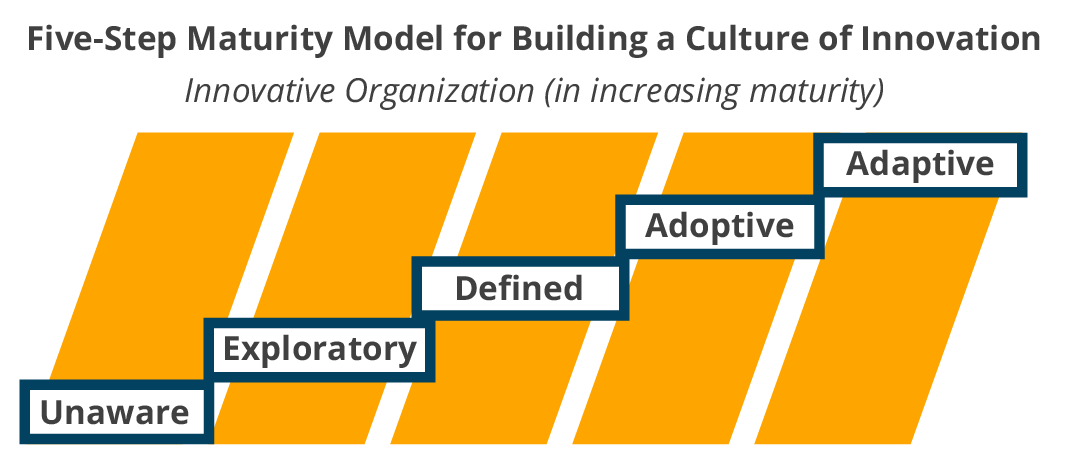
Chapter 8: Grow the Program as a Whole
Areas of Growth for Your Program
At this point in your journey, you have likely taken several foundational steps in developing a culture of innovation, such as recognizing existing successes, forming your culture of innovation team, making your program official, building your personalized playbook, and implementing and maintaining some plays. You are now at a critical juncture; if you lose momentum, your efforts will start to wane, and your organization may not see the value in continuing the investment. Beyond the specific plays in your playbook, your program itself needs to grow and mature if it is going to bear the results you are striving for.
This chapter provides the following steps for growing your culture of innovation program:
- Tend to your culture of innovation team. Is it expanding and evolving?
- Keep trying new things. What new problems need solutions?
- Keep moving forward. Are you focused on successes?
- Keep evaluating. Have you developed metrics?
Tend to Your Culture of Innovation Team
Ideally, your team should never stop growing and progressing. To that end, here are some categories to consider when evaluating your team to ensure that it focuses on growth:
- Performance. How is the team performing?
- Evolution. How is your team evolving?
- Leadership. What is happening to leaders, and are new ones being cultivated?
- Goals. Are goals being prioritized and met, or is there contention?
- Communication. Are all ideas welcome, and are they heard and valued?
- Team relationships. Are trust and strong relationships being built?
- Cross-functional collaboration. Is supportive collaboration being developed?
- External partnering. Is your team learning from others and growing?
- Motivation/incentives. Are team members inspired to tackle new ideas?
- Recognition. Are team members adequately recognized for their contributions?
- Mindset. Is your team's mindset evolving? Is it becoming a cultural mindset?
Keep Trying New Things
A continuous flow of new ideas is needed to keep innovation moving forward. It is important for the team to always be asking what new problems need to be solved. To that end, some areas to evaluate include
- Continual improvement. Are team members finding new challenges and needs to address?
- Knowledge transfer. Are team members documenting and sharing progress?
- Managing risk. Are team members collaborating or partnering to find ways to mitigate risk?
- Relationship development. Is your team establishing and deepening relationships within, across, and outside the organization with partners to help solve different challenges?
- Playbook/strategy. Does your team continually evaluate and assess progress on current and new plays? Has the playbook been disseminated and shared widely?
- New perspectives. Does your team receive new training methods for skill development and career advancement?
Keep Moving Forward
Moving forward means ensuring that your team's fruitful ideas keep progressing while ideas that are not working are let go. Some ways to ensure this include evaluating your team's progress in the following areas:
- Actionability. Is the team just producing ideas and concepts, or is it driving action?
- Gathering feedback. Are team members continually adding to their list of successes and unsuccessful attempts, finding out the “why” behind both, and transferring this knowledge to the rest of the airport?
- Getting to the root. Does the team (and the airport) understand that a project's failure is an acceptable part of the process, and its new goal should be to learn from the experience?
- Understanding/replicating. Does the team understand what was done well in a successful project so that those actions can be replicated in appropriate ways in the future?
- Acceptance. Are the team's solutions accepted and embraced by those impacted by the solutions? If not, what tactics can you take to lead them to acceptance?
- Monitoring. Is the team identifying and tracking any issues arising from the solutions? Are team members continually monitoring and improving so that they can truly celebrate results?
- Planned implementation. Do your team members explain how they make informed decisions, prioritize projects, and weigh budget and risk in the process so that they can execute some ideas in a confident and measured way?
Keep Evaluating
Refer back to the fruits, trees, and soil example from Chapter 1. If you want to drive innovation and continuous improvement into the culture, you need to measure how well the “soil” is being nourished. Developing metrics to measure progress is a good way to make sure your culture of innovation program grows.
The following are a few examples of areas to measure:
- Total hours or percentage of time spent on innovation or problem-solving activities, as indicated on timesheets.
- How many people have been trained in innovative areas of study.
- Staff satisfaction levels when it comes to participating in the innovation process or on innovative teams.
- Leaders and managers can also be evaluated on any innovation training received or how often they apply innovative tools, like an innovative playbook or plan.
It is important that your measurement metrics
- Are clear to everyone so that they can always find new ways to meet them;
- Do not encourage people to focus on reaching numbers rather than being truly interested in improving the way things currently are;
- Are communicated to your entire organization; and
- Do not come with unexpected side effects that can feel punitive to leaders or staff.
Much like the growth of a tree, your program's work to transition your organization's culture and mindset will take time. Your organization should prepare itself and anticipate slow progress.
Assessing the Maturity of Your Culture of Innovation
Your culture of innovation program's progress and growth can be demonstrated by a maturity model. In The Collaborative Organization, Jacob Morgan creates a five-step maturity model for building a collaborative organization.1 And the research completed for this WebResource uncovered that a collaborative culture is very closely aligned with an innovative one. Furthermore, several of the case study interviewees demonstrated that their culture of innovation had grown from their culture of collaboration.
Chapter 2 demonstrates how innovation can be driven into an airport's culture through five organizational elements (leadership, staff, strategy & policy, organizational structure, and process & procedure). It also introduces the innovative mindset that individuals need in order to spark innovative change in an organization. Once many people in an organization take on this mindset, it becomes the culture's mindset.
Building on all of these concepts, Figure F8.1 presents a five-step maturity model to evaluate your culture of innovation.

Figure F8.1: Five-Step Maturity Model for Building a Culture of Innovation.
The five cultural mindsets depicted in Figure F8.1 are as follows:
- Unaware. Neutral or not open to change or new ideas, possibly even fearful of change.
- Exploratory. More open to change and experimenting than the unaware mindset.
- Defined. More open to change and experimenting than the exploratory mindset.
- Adoptive. Open to change, experimental, collaborative, inspired by others' successes, and seeking feedback.
- Adaptive. Open to change, experimental, collaborative, inspired by others' successes, seeking feedback, resisting a mindset of failure, learning from setbacks, and accountable.
This model shows how far your culture of innovation program can take you if your organization supports and enables it. Make it a habit to occasionally refer to this model as you assess where your organization currently stands, areas where progress has been nurtured, and areas that need more tending or pruning.


1 Jacob Morgan, The Collaborative Organization, p. 219, McGraw Hill (New York, NY), 2012, https://thefutureorganization.com/books/.


